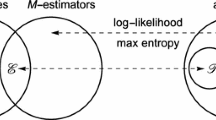Abstract
As is known, regression-analysis tools are widely used in machine-learning problems to establish the relationship between the observed variables and to store information in a compact manner. Most often, a regression function is described by a linear combination of some given functions fj(X), j = 1, …, m, X ∈ D ⊂ Rs. If the observed data contain a random error, then the regression function reconstructed from the observations contains a random error and a systematic error depending on the selected functions fj. This article indicates the possibility of an optimal, in the sense of a given functional metric, choice of fj, if it is known that the true dependence obeys some functional equation. In some cases (a regular grid, s ≤ 2), close results can be obtained using a technique for random-process analysis. The numerical examples given in this work illustrate significantly broader opportunities for the assumed approach to regression problems.




Similar content being viewed by others
REFERENCES
N. Draper and H. Smith, Applied Regression Analysis, 3rd ed. (Wiley, New York, 1998; Dialektika, Kyiv, 2016).
I. Ts. Gokhberg and M. G. Kreyn, Introduction to the Theory of Linear Non-Self-Adjoint Operators in a Hilbert Space (Nauka, Moscow, 1965; American Mathematical Society, Providence, R.I., 1969), in Ser.: Translations of Mathematical Monographs, Vol. 18.
V. I. Donskoi, “Machine learning and learnability: Comparative survey,” Available at Intellectual Archive, paper no. 933 (2012).
K. D. Usevich, “Decomposition of functions in 2D-extension of SSA and related partial differential systems of equations,” Vestn. S.-Peterb. Univ., Ser. 10: Prikl. Mat., Inf., Protsessy Upr., No. 3, 151–160 (2009).
S. M. Ermakov and L. Yu. Kotova, “On the choice of basic functions in regression analysis,” in Collection of Works of the Department of Statistical Modeling of St. Petersburg State University (1999), pp. 3–43 [in Russian].
A. A. Samarskii, The Theory of Difference Schemes (Moscow, Nauka, 1989) [in Russian].
N. E. Golyandina and K. D. Usevich, “2D-SSA Method for analysis of two-dimensional fields,” in System Identification and Control Problems: Proc. 7th Int. Conf. (SICPRO’08), Moscow, 2008 (Inst. Probl. Upr. im. V. A. Trapeznikova Ross. Akad. Nauk, Moscow, 2008), pp. 1657–1727.
Author information
Authors and Affiliations
Corresponding authors
Ethics declarations
CONFLICT OF INTEREST
We declare that we have no conflicts of interest.
ADDITIONAL INFORMATION
Cite this work: Ermakov S.M. and Leora S.N., On the choice of regression basis functions and machine learning, Vestn. S.-Peterb. Univ., Ser. 1: Mat., Mekh., Astron., 2022, vol. 9 (67), no. 1, pp. 11–22 (in Russian). https://doi.org/10.21638/spbu01.2022.102
Additional information
Translated by O. Pismenov
About this article
Cite this article
Ermakov, S.M., Leora, S.N. On the Choice of Regression Basis Functions and Machine Learning. Vestnik St.Petersb. Univ.Math. 55, 7–15 (2022). https://doi.org/10.1134/S1063454122010034
Received:
Revised:
Accepted:
Published:
Issue Date:
DOI: https://doi.org/10.1134/S1063454122010034




